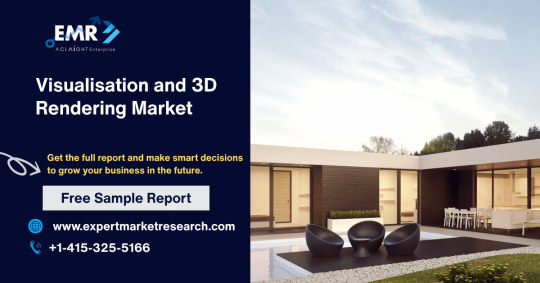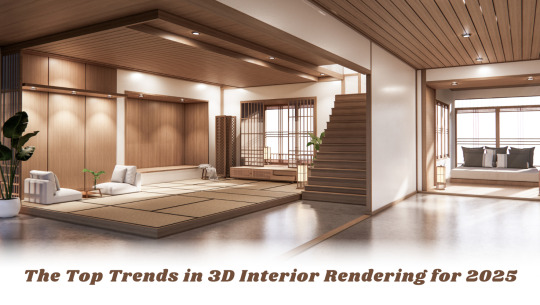#RenderingTechnology
Explore tagged Tumblr posts
Text
Visualisation and 3D Rendering Market: Trends, Technologies, and Future Outlook

The visualization and 3D rendering market has experienced significant growth in recent years and is poised for an even brighter future. With advancements in technology and an increasing demand for high-quality visuals in various industries, the market reached a value of USD 3.28 billion in 2024 and is projected to grow at an impressive CAGR of 22.10%, reaching USD 24.16 billion by 2034. This rapid expansion can be attributed to the growing use of 3D rendering across a range of applications, from architecture to entertainment and gaming. As businesses and industries continue to embrace digital transformation, the need for realistic and immersive visual content will only continue to rise.
Current Trends in the Visualization and 3D Rendering Market
Several trends are currently shaping the visualization and 3D rendering market, with technology and consumer demand playing significant roles. One of the most notable trends is the increased use of real-time rendering. Unlike traditional rendering methods, real-time rendering allows for the instant creation of 3D images and animations, enabling quicker decision-making processes, especially in design and product development. This has proven to be particularly beneficial in industries such as architecture, automotive design, and gaming, where the need for rapid prototyping and visualization is critical.
Another key trend is the growing adoption of augmented reality (AR) and virtual reality (VR) in 3D rendering applications. Both AR and VR technologies rely heavily on high-quality 3D visuals to deliver immersive experiences. In industries like real estate, retail, and education, businesses are incorporating 3D rendering to enhance customer engagement and create realistic virtual environments for training, product demonstrations, and simulations. This integration of AR and VR with 3D rendering technology is expected to drive the market’s growth further.
Moreover, the use of cloud-based rendering services is rapidly increasing. Cloud-based platforms offer flexibility and cost-effectiveness, allowing users to access powerful rendering tools without needing to invest in expensive hardware. These platforms also enable the collaboration of global teams, making it easier to manage large-scale rendering projects. As companies continue to shift towards cloud-based solutions, the demand for cloud rendering services will continue to increase, expanding the reach of the 3D rendering market to small and medium-sized enterprises.
Technological Advancements Driving Market Growth
Several cutting-edge technologies are contributing to the growth and evolution of the visualization and 3D rendering market. One of the most significant advancements is the rise of ray tracing. This technique simulates the way light interacts with objects, creating realistic lighting, shadows, and reflections. The integration of ray tracing in real-time rendering engines has drastically improved the quality of 3D visuals, making them almost indistinguishable from real-life images. As ray tracing becomes more accessible with the development of advanced GPUs, the demand for highly detailed and realistic 3D renderings will continue to grow across industries such as gaming, film production, and architecture.
Another breakthrough technology is AI-powered rendering. Artificial intelligence and machine learning are being used to speed up the rendering process, making it more efficient and reducing the computational power required. AI algorithms can optimize various rendering processes, such as texture mapping and lighting adjustments, allowing for faster results without sacrificing quality. This innovation is particularly useful in industries that require high volumes of 3D content creation, such as the gaming industry, where studios need to produce vast amounts of detailed content in a short amount of time.
Additionally, 3D printing and parametric modeling are becoming increasingly integrated with visualization and rendering technologies. These tools allow for the creation of physical prototypes based on 3D models, with designers and engineers able to visualize and test their ideas before committing to manufacturing. This synergy between 3D rendering and 3D printing has proven to be invaluable in sectors such as automotive, aerospace, and healthcare, where precision and innovation are paramount.
Future Outlook of the Visualization and 3D Rendering Market
Looking ahead, the visualization and 3D rendering market is set to experience continued growth driven by several key factors. As more industries adopt AI, machine learning, and cloud technologies, the need for high-quality and real-time rendered content will continue to rise. These innovations are not only making rendering more efficient but are also lowering the entry barriers for smaller companies to access high-quality 3D rendering tools.
The future of the 3D rendering market will also see increased use in interactive and immersive experiences. The rise of the metaverse, a virtual world where users can interact with digital environments and other users, is expected to drive the demand for realistic 3D environments. In the coming years, 3D rendering will play a critical role in shaping the visual landscapes of the metaverse, creating immersive worlds for users to explore, socialize, and work in. As these virtual spaces become more mainstream, the demand for sophisticated 3D rendering solutions will only grow.
Moreover, the increasing popularity of smart cities and urban planning initiatives will push the need for advanced visualization tools. With growing urbanization, there is a greater emphasis on smart city projects that integrate sustainable design, energy efficiency, and advanced infrastructure. These projects require detailed visualizations and 3D renderings to evaluate various designs, assess impacts, and visualize the future urban landscape.
Finally, with the rise of the gaming industry, demand for ultra-realistic graphics, 3D models, and animations is expected to continue growing. As next-generation gaming consoles and platforms push the boundaries of what is visually possible, the need for increasingly sophisticated rendering technologies will continue to be a significant driver of market expansion.
Conclusion
The visualization and 3D rendering market is on a strong upward trajectory, thanks to advances in real-time rendering, AI-powered tools, and the integration of cloud computing. With a growing range of industries, from architecture and real estate to gaming and entertainment, adopting these technologies, the demand for high-quality visual content will continue to increase. As the market grows, we can expect more innovative technologies to emerge, further enhancing the realism, speed, and accessibility of 3D rendering solutions.
With its projected growth, this market presents a wealth of opportunities for both established players and new entrants to innovate and shape the future of digital content creation. For more detailed market insights and in-depth reports, visit Expert Market Research (EMR), a trusted source for comprehensive market analyses and forecasts.
#3DRendering#Visualization#3DVisualization#TechTrends#RenderingTechnology#3DModeling#VirtualReality#FutureOfTechnology#VisualizationMarket#ExpertMarketResearch#market report#market insights
0 notes
Text
Top 3D Interior Rendering Trends You Need to Know for 2025

As we approach 2025, cutting-edge technologies are transforming the landscape of 3D interior rendering. From AI-driven tools and photorealistic visuals to immersive VR and AR experiences, this blog highlights the key trends revolutionizing interior design. Learn how these advancements are enhancing personalization, efficiency, and client satisfaction in the design process. Click the link to explore the future of 3D interior rendering and stay ahead of the curve!
#3dinteriordesign#renderingtechnology#interiordesigntrends#photorealisticrendering#aiinteriordesign#virtualrealitydesign#augmentedreality#sustainableinteriors#custominteriordesign#smarthomedesign
0 notes
